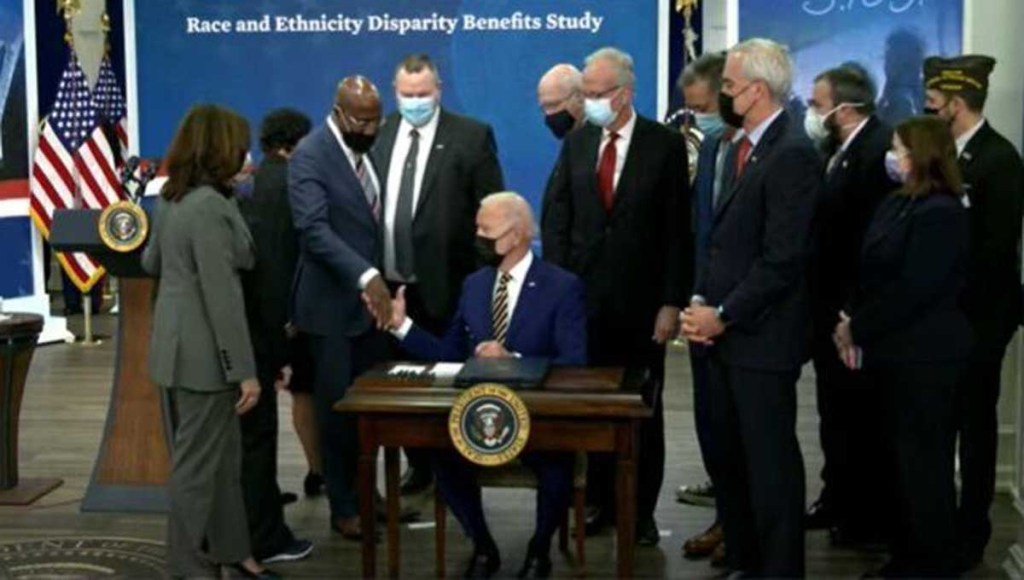Feds probe lagging benefits for Black veterans
Published 1:45 pm Friday, December 3, 2021

- Sen. Rev. Raphael Warnock’s legislation to address disparities in benefits for veterans of color was signed into law by President Joe Biden Nov. 30 during a ceremony at the White House.Photo submitted by Sen. Raphael Warnock's office
WASHINGTON — Black veterans having difficulty accessing benefits may be getting some help from the federal government.
An initiative signed into law earlier this week charges the Government Accountability Office with performing a study to assess disparities associated with race and ethnicity in veterans receiving benefits from the Department of Veterans Affairs.
Led by Georgia Sen. Raphael Warnock, the study will examine minority access to VA compensation benefits, disability ratings with a focus on pain assessment and rejections of fully developed claims.
“This law pushes us one step closer to fully understanding the VA’s standard of care so we can identify and address the systemic challenges facing some of our veterans, and ensure that all our veterans are receiving the equal and just care they earned in courageous service to our country,” Warnock said.
Congress is expected to be briefed on the findings of the study in one year and then presented recommendations within eight months.
The initiative comes following pressure from organizations such as Black Veterans Project, an advocacy group that focuses on addressing systemic racial inequities across the military and veteran landscape.
The group partnered with Yale Law School’s Veterans Legal Services Clinic to research disparities among minority veterans and much of the research is still in progress.
Richard Brookshire, BVP’s board chair, said Black veterans are 29% less likely to receive disability compensation for PTSD, compared to white veterans.
“And that’s just in 2020-21,” Brookshire said of findings from the research thus far. “We’re not talking about the fact that you’re talking about the intentional siphoning of literally trillions of dollars over the course of many decades out of the Black community through benefit obstruction.”
Oftentimes when Black veterans are approved for benefits, it’s a lengthy process, he said. He referenced the case of a Black Vietnam veteran who waited nearly 45 years before receiving a discharge upgrade to begin accessing his benefits.
“(It’s) indicative of a vast number of Black vets that have been locked out of not only just the GI Bill or access to health care at the VA, but specifically disability benefits because I think most people don’t quite understand how benefit obstruction works, because most people don’t understand the bureaucracy of the VA, or just the different mechanisms that obstruction can happen in. So you obviously have just blanket racism that can occur in the military and has occurred historically,” Brookshire said.
The most recent available VA Minority Veterans Report from 2014 provides a summary of benefits received by minority veterans from the department.
The report indicated that the amount of minority veterans who used at least one VA benefit or service had grown from 35.2% in 2005 to 44.1% in 2014. Of the 32% minority veteran population who used VA programs in 2014, 51.2% received disability payments, 24.1% had a VA home loan guarantee, 9.6% had a life insurance policy administered or supervised by VA.
In its annual reports, the VA does not provide a detailed breakdown of benefits by race or ethnicity, but does provide age groups and dollar amounts issued for certain benefits.
Yale filed a lawsuit against the VA in June after several VA offices failed to respond to BVP’s FOIA requests for documents pertaining to disability compensation benefits and health care services, broken down by race and gender.
According to a release from Yale, BVP and the National Veterans Council for Legal Redress also sought records pertaining to internal reviews or studies of racial bias, discrimination complaints, and anti-discrimination policies and training for VA employees.
General veteran information for a few of CNHI‘s southern states, per recent VA reports:
Alabama
More than 362,000 veterans live in the state, with an estimated 111,000 receiving $2.16 billion in compensation for year 2020. At the end of 2020, an estimated 9,900 veterans had insurance through the VA — an estimated face value of $117.7 million.
In 2018, the VA reported an estimated 28% of veterans living in Alabama were non-white.
Georgia
Of the more than 696,100 veterans living in Georgia, nearly 215,000 of them received $4.2 billion in compensation through the VA, according to the report. There were more than 18,500 insurance policies through the VA in 2020, a cost of $220,015,841.
Nearly 38% of Georgia’s veterans in 2018 were races other than white.
Mississippi
Nearly 50,000 of the state’s estimated 185,000 veterans received a total of $927.5 million in compensation through the VA in 2020. Only 4,4438 insurance policies — totaling $53.6 million — were through VA, according to the VA report.
VA data shows that an estimated 31% of veterans in Mississippi were nonwhite in 2018.
Tennessee
Tennessee veterans — 132,598 of the 456,196 total veteran population — received nearly $2.5 billion in compensation from the VA last year. The VA reported more than $126.77 million in insurances costs for 10,489 veteran policies.
Sixteen percent of the state’s population in 2018 were races other than white, according to a VA report.





